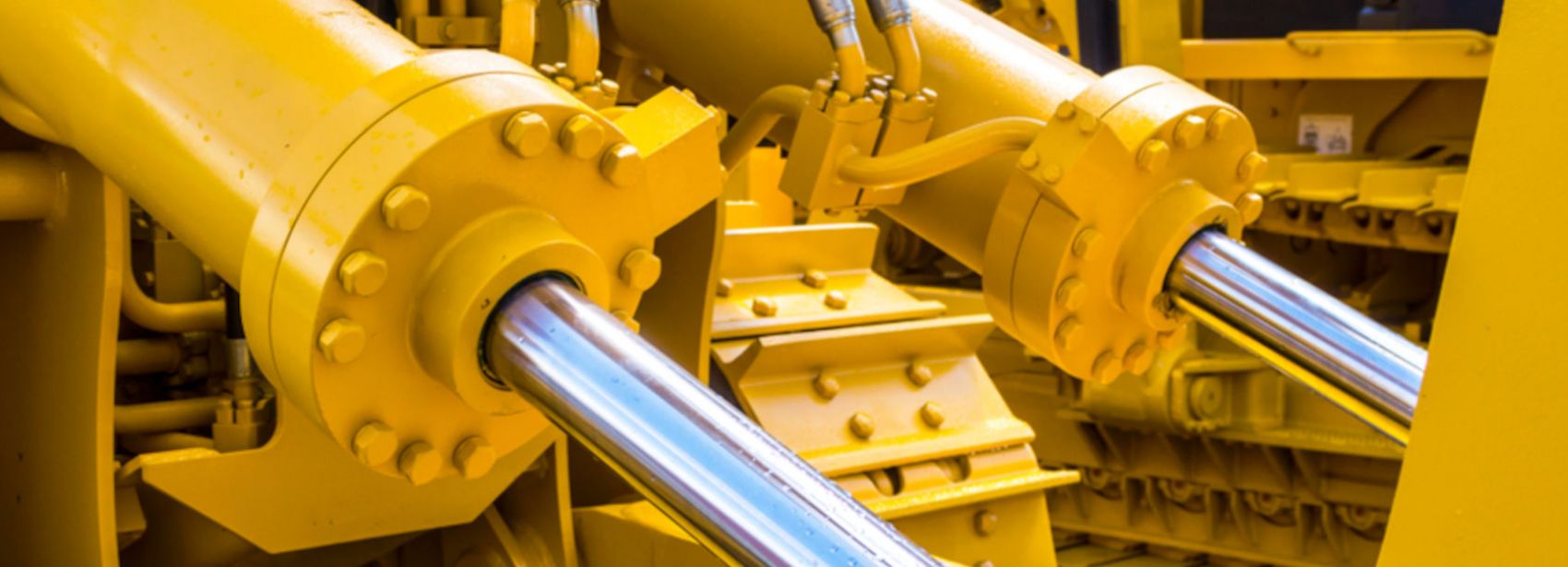
Hydraulic cylinders have been referred to as actuators, rams. hydraulic jacks and linear hydraulic motors. In a hydraulic system, cylinders are used to do the heavy lifting. Hydraulic cylinders utilise Pascal's Law to deliver incredible forces in precise movements and are used in any system where a strong push or pull force is required. If you aren't quite confident with your hydraulic calculations and equations, then take a look here for a refresher.
Key words:
Piston - a disc or short cylinder fitting closely within a tube in which it moves up and down against a liquid or gas, used in a pump to impart motion
A hydraulic cylinder utilizes hydraulic fluid such as oil supplied by a hydraulic pump. The hydraulic pump forces fluid into the cylinder often via a hydraulic hose. As the fluid enters the cylinder inlet, pressure beings to build up within the piston and the piston rod begins to drive upwards. When resistance in the form of a heavy load or other application, is added to the other side of the rod, the fluid pressure within the piston increases. As the load increases, the pressure continues to increase until either there is no more resistance, or the fluid pressure exceeds the limits of the system and leaks.
A cylinder barrel is part of a hydraulic cylinder. A piston and piston rod are housed inside this barrel and move linearly back and forth through the cylinder. The cylinder bottom and cylinder head seal the cylinder barrel on both ends. The cylinder head may be seen through the piston rod.
Sliding rings and seals are used to seal the fluid inside the cylinder, which is an absolutely crucial element of the pressure build-up inside the cylinder itself, which allows the cylinder to produce such powerful forces. These sliding rings and seals sit on the inside of the cylinder barrel. The piston divides the cylinder into two chambers, the bottom chamber (cap end) and the piston rod side chamber (rod end). Hydraulic pressure acts on the piston to do linear work and motion. A piston can be mounted to the object or machine component that it is pushing via flanges, trunnions or clevises that are mounted to the cylinder body.
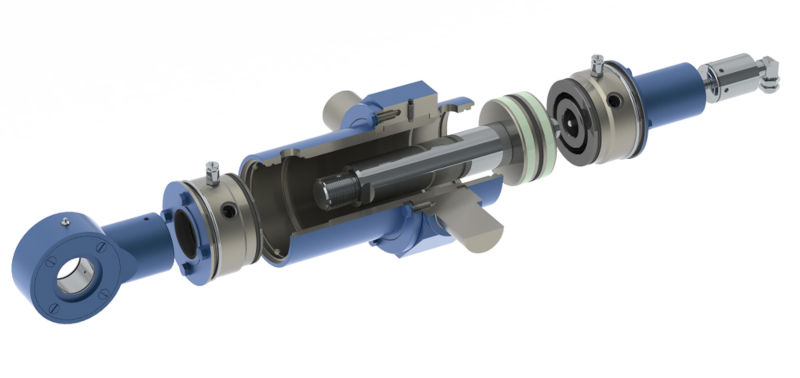
A single acting hydraulic cylinder works much like a double acting cylinder, except instead of being able to act in both directions, a single acting cylinder only produces a force in one direction. A single acting cylinder is used where either a push or pull force is required, not both, however. Fluid only acts on one side of the rod to assist its. Once the pressure is gone, a spring or external force such as gravity is used to retract the piston to its starting position.
A double acting cylinder can be used in applications where the thrust or output force is needed for both the extending and retracting directions of movement. A double acting cylinder has a port at both the advance end and the retract end of the cylinder barrel and these ports move the piston forward and backward by alternating the port that releases the high-pressure fluid.
A telescopic cylinder can provide an incredibly long stroke from a very compact position. Usually, the collapsed length of a telescopic cylinder is between 20% and 40% of their extended length; this makes a telescopic cylinder ideal for applications where a long stroke is needed but mounting space is compact.
As the name suggests, a telescopic cylinder is constructed like a telescope, with sections of steel tubing with successively smaller diameters nested within each other. The section with the largest diameter is called the main or barrel whilst the smaller sections are named stages. The stage with the smallest diameter is known as the plunger. As it stands, a practical maximum number of moving stages is six - any more than six and the structure becomes very unstable.
These types of cylinders utilise a cylinder within a cylinder design in order to increase the distance that a rod can travel in a single stroke. The stroke is the distance a cylinder can move in one movement. Telescopic cylinder can be either single or double acting. Potential downsides of this design type include the fact that telescopic cylinders can have sudden changes in speed due to changes in the volume size for the different cylinder stages. There are specialist engineers that can avoid this pitfall however, by designing dual acting telescopic cylinders that move at constant speed.
There are two main types of hydraulic jack: floor jacks and bottle (or screw) jacks.
Bottle jacks tend to have cylindrical bodies and necks, with a resemblance to a bottle and are sometimes referred to as whiskey jacks. Bottle jacks can be used for the repair of automobiles and house foundations as well as short vehicle lifts. A floor jack can provide a broader range of vertical lift. Floor jacks have a horizontal shaft that pushes on a crank in order to vertically lift a pad, as opposed to bottle jacks, with which you turn the crank manually.
These are mobile cylinders that come in a range different size. Usually, a one hand pump can be used for this application which means that a company could feasibly select its own cylinder size for each job. Jack cylinders tend to not have a mount but instead are operated from the floor. typical lifting weights range from 5 all the way to 50 tonnes. because of the standardised sizing and mobile nature of the jack cylinder, they are ideal tools for hire, if they aren’t needed regularly - in most cases jack cylinders are hired out for a specific job as opposed to owned outright.
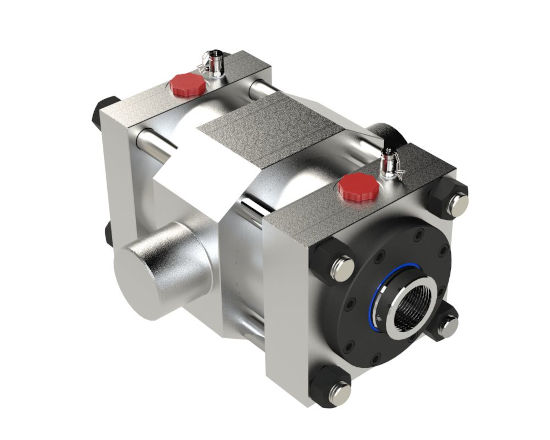
The two end caps of the cylinder barrel are held in place by threaded steel rods in tie rod hydraulic cylinders. This construction technique is frequently used in industrial enterprises. Small-bore cylinders typically use 4 tie rods, however large-bore cylinders may need up to 20 tie rods to hold the end caps in place to withstand the tremendous stresses. At high pressures and long strokes, tie rod stretch can cause failure.
To see our current range of tie-rod cylinders, please click here.
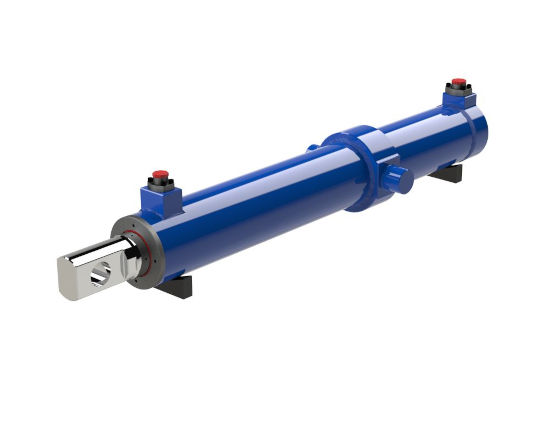
There are no tie rods on this type of hydraulic cylinder. Instead, the front rod gland is typically threaded into or fastened to the cylinder barrel after the barrel is directly joined to the end caps and the ports are joined to the barrel.
This makes it possible to remove the piston rod assembly and the rod seals for upkeep. The thinner body and shorter overall length of welded body cylinders make them more adaptable to tighter spaces within machinery. The welded construction also makes it easier to customise since the cylinder body may easily be enhanced with unique features. A welded body cylinder may adopt specific ports, unique mounts, or valve manifolds, to name just a few potential distinctive characteristics. The mobile hydraulic equipment market is dominated by welded body hydraulic cylinders with applications in construction (excavators, bulldozers etc.) and material handling equipment (forklift trucks and tail lift gates etc.)
To see our current range of welded body hydraulic cylinders, look here.
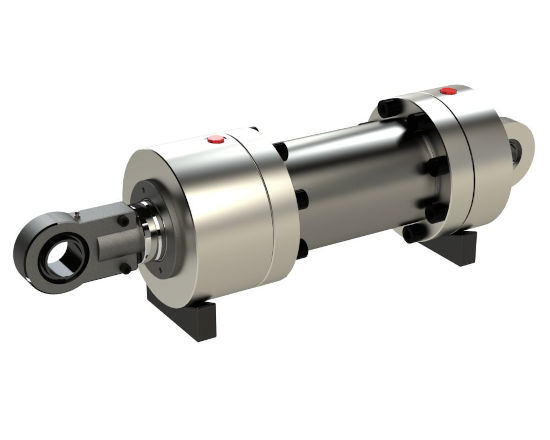
This type of cylinder, sometimes called a Mill type cylinder, is a cylinder made to meet the demand for a more robust, dependable product to lower maintenance costs and downtime. The mill-type cylinder is made with heavy-duty materials, including heavy-wall steel tubing, steel flanged end caps, larger pistons, and enhanced gland design. Additionally, the mill-type cylinder has a high pressure rating that exceeds industry norms. Together, these qualities guarantee better dependability even under the worst operating and environmental circumstances.
Click here to learn more about how Zeus Hydratech can help your company meet its goals with regards to hydraulic cylinders. Or, if you have any further questions, feel free to contact us at +44 (0)1172 130042 to speak to one of our technical team.
Vat Reg Number: 846644204 Company Registration Number: 5230249
© Copyright 2026 Zeus Hydratech | All Rights Reserved